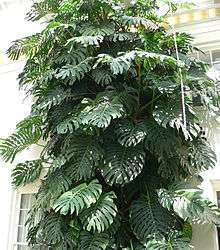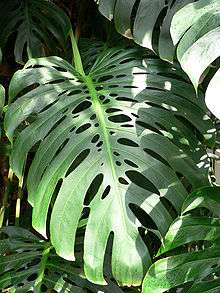Monstera deliciosa
| Monstera deliciosa | |
|---|---|
 | |
| Scientific classification | |
| Kingdom: | Plantae |
| Clade: | Angiosperms |
| Clade: | Monocots |
| Order: | Alismatales |
| Family: | Araceae |
| Genus: | Monstera |
| Species: | M. deliciosa |
| Binomial name | |
| Monstera deliciosa | |
Monstera deliciosa is a species of flowering plant native to tropical forests of southern Mexico, south to Panama.[1] It has been introduced to many tropical areas, and has become a mildly invasive species in Hawaii, Seychelles, Ascension Island and the Society Islands.
Names
The specific epithet deliciosa means "delicious", referring to the edible fruit, while monstera means "monstrous," in reference to the size that this plant can grow to—over 30 ft (9.1 m) in many cases.
Common names include fruit salad plant, fruit salad tree (in reference to its edible fruit, which tastes similar to a fruit salad),[2] ceriman, Swiss cheese plant (or just cheese plant), monster fruit, monsterio delicio, monstereo, Mexican breadfruit, windowleaf, balazo, Penglai banana and (inaccurately) split leaf philodendron.[3] The names in Spanish (costilla de Adán), Portuguese (costela-de-adão), and French (plante gruyère) refer to the change of the leaves from entire to fenestrated (comparing it in the first two cases with the ribs of Adam and in the third with the hole-filled gruyère cheese). In Mexico, the plant is sometimes referred to as piñanona.
Description
This member of the arum family Araceae is an epiphyte with aerial roots, able to grow up to 20 m (66 ft) high with large, leathery, glossy, heart-shaped leaves 25–90 cm (10–35.5 in) long by 25–75 cm (10–29.5 in) broad. Young plants have leaves that are smaller and entire with no lobes or holes, but soon produce lobed and fenestrate leaves.[4][5]
Wild seedlings grow towards the darkest area they can grow until they find a tree trunk, then start to grow up towards the light, creeping up the tree.[6][7]
The flower of M. deliciosa is composed of a special bract called a spathe enclosing a spadix. These flowers are bisexual, meaning they contain both androecium and gynoecium.[8] Since they contain both structures, this plant is able to self-pollinate.
Cultivation
Monstera deliciosa is commonly grown for interior decoration in public buildings and as a houseplant. It grows best between the temperatures of 20–30 °C (68–86 °F) and requires high humidity and shade. Growth ceases below 10 °C (50 °F) and it is killed by frost. In the coastal zones of Sicily, especially in the Palermo area, where it is called "zampa di leone" ("lion's paw"), it is often cultivated outdoors. In ideal conditions it flowers about three years after it is planted. Flowering is rare when grown indoors. The plant can be propagated by taking cuttings of a mature plant or by air layering.
Monstera deliciosa[9] and the cultivar 'Variegata'[10] have gained the Royal Horticultural Society's Award of Garden Merit.[11]
Fruit
The fruit of Monstera deliciosa is up to 25 cm long and 3–4 cm diameter, looking like a green ear of maize covered with hexagonal scales. As the fruit ripens, these scales or platelets fall off the fruit, releasing a strong and sweet scent. The smell has been compared to a combination of pineapples and bananas.[12] The fruit is edible and safe for humans.[13]
Forcing a M. deliciosa to flower outside of its typical tropical habitat proves to be difficult. Specific conditions need to be met for the plant to flower. However, in its tropical and subtropical habitat, the plant flowers easily.[13] In these areas where it grows naturally, M. deliciosa is considered a delicacy due to its sweet and exotic flavor.
Fruits of plants of the Araceae (Arum family) often contain Raphides and Trichosclereids – needle-like structures of calcium oxalate. In M. deliciosa, unripe fruit containing these needle-like crystalline structures can cause irritation of the mouth.
The fruit first shows signs of ripening by its bottommost scales becoming yellowed. As it ripens, the starch that was stored in the green fruit is converted to sugar, giving it its sweet flavor. This mechanism is comparable to how banana fruits ripen. The strong odor the fruit produces becomes noticeable when it is half-ripe. As time passes and the fruit continues to ripen, the odor becomes stronger. After it becomes fully ripe, however, the scent deteriorates quickly.[13][14]
The fruit may be ripened by cutting it when the first scales begin to lift up and it begins to exude a pungent odor. It is wrapped in a paper bag and set aside until the scales begin popping off. The scales are then brushed off or fall away to reveal the edible flesh underneath. The flesh, which is similar to pineapple in texture, can be cut away from the core and eaten. It has a fruity taste similar to jackfruit and pineapple. The unripe green fruits can irritate the throat and the latex of the leaves and vines can create rashes in the skin, because both contain potassium oxalate: that is the reason why the fruits have to be consumed when the scales lift up.[15] The black irritant fibres can be swept off with the application of a little citrus juice.
Plants grown indoors in temperate regions occasionally produce flowers and fruit.
Other uses
The aerial roots have been used as ropes in Peru, and to make baskets in Mexico.[6]
In Mexico, a leaf or root infusion is drunk daily to relieve arthritis.[6]
In Martinique the root is used to make a remedy for snakebite.[6]
In Colombia it is used as a decorative plant.[16]
- Monstera fruit ripening
- Monstera fruit (unripe)
 Monstera flower
Monstera flower Leaf
Leaf Leaf and flower
Leaf and flower Growing fruit
Growing fruit
References
- ↑ "Monstera deliciosa". Germplasm Resources Information Network (GRIN). Agricultural Research Service (ARS), United States Department of Agriculture (USDA). Retrieved 2009-02-10.
- ↑ Daleys Fruit Tree Nursery, Kyogle, New South Wales, Monstera Fruit Salad Tree
- ↑ Bartholomew, Terese Tse, et al. (eds.). The Charming Cicada Studio: Masterworks by Chao Shao-an. Asian Art Museum of San Francisco, 1997. p40.
- ↑ http://www.hort.purdue.edu/newcrop/morton/ceriman.html Fruits of warm climates pp. 15–17 (1987) access date 2010-07-09
- ↑ Liebmann, Frederik Michael. 1849. Videnskabelige Meddelelser fra Dansk Naturhistorisk Forening i Kjøbenhavn 1849: 19, Monstera deliciosa
- 1 2 3 4 Online reference to Monstera deliciosa
- ↑ https://www.youtube.com/watch?v=Kej6HDDMr5o
- ↑ Barabé, Denis (1984). "Volatile flavor constituents of Monstera deliciosa". Jardin botanique de la Ville de Montréal.
- ↑ "RHS Plant Selector – Monstera deliciosa". Retrieved 25 May 2013.
- ↑ "RHS Plant Selector – Monstera deliciosa 'Variegata'". Retrieved 25 May 2013.
- ↑ "AGM Plants - Ornamental" (PDF). Royal Horticultural Society. July 2017. p. 64. Retrieved 4 April 2018.
- ↑ Peppard, Terry (1992). "Volatile flavor constituents of Monstera deliciosa". Journal of Agricultural and Food Chemistry. 40: 257–262. doi:10.1021/jf00014a018.
- 1 2 3 Peters, R. E.; Lee, T. H. (1977). "Composition and physiology of Monstera deliciosa fruit and juice". Journal of Food Science. 42 (4): 1132–1133. doi:10.1111/j.1365-2621.1977.tb12687.x.
- ↑ https://www.youtube.com/watch?v=EUwynW-Tfs8
- ↑ "Plantas silvestres alimenticias fe uso tradicional en las comunidades de Pacurita, San José de Purre y Guayabal". Reuna.unalmed.edu.co. Retrieved 2012-01-30.
- ↑ "Balazo – Monstera deliciosa Liebm – Banco de Objetos de Aprendizaje y de Información" (in Spanish). Aprendeenlinea.udea.edu.co. Retrieved 2012-01-30.
External links
| Wikimedia Commons has media related to Monstera deliciosa. |
| Wikispecies has information related to Tribu Monstereae |